
As pet ownership continues to soar in the United States, the demand for high-quality pet food products and efficient processing has reached unprecedented heights in recent years. Pet owners are increasingly discerning about the quality, nutrition and safety of the food they provide to their beloved animal companions.
In 2022, a private-label pet food manufacturer based in Terre Haute, Indiana, embarked on a quest to expand operations and enhance its processing flexibility, efficiency and commitment to sustainability and high-quality pet food products. Teaming up with an engineering firm and sanitary systems integration expert, the pet food manufacturer set out to design and install a sanitary fluid transfer system that would grow and transform its pet food manufacturing process. This system combined proven and trusted methods used every day in food processing for human consumption and applied these principles to pet food production.
Efficiency & Flexibility: Meeting the Demands of Pet Owners
Recognizing the need for processing flexibility in an industry that caters to multiple brands, the pet food manufacturer sought to expand the use of the time-tested methods utilized in human food processing. Although not widely the standard in all pet food processing, it had already embraced some of these processing methods in other manufacturing areas. The company knew by applying these proven methods, it could ensure the quality and elevate the variety of pet food products it offered while maintaining peak processing efficiency.
Efficient Flow: Applying Proven Methods With Precision
To achieve efficient flow for maximum processing flexibility, the pet food manufacturer utilized stainless-steel flow panels, a decades-old and proven method for effectively, cleanly and securely directing fluids for manufacturing in sanitary processing environments. The flow panels, with the hygienic fluid handling equipment and process piping, ensured exceptional fluid flow during production and cleaning.
The bevel seat flow panel and stainless-steel process piping provide a clean break to the atmosphere, reducing the risk of unintentional mixing or improper transfers. Flow panels provide an ideal alternative to more expensive or less effective flow diversion options and are widely utilized in a variety of hygienic processing industries.
By integrating these methods, the pet food manufacturer is able to maintain the highest standards of product integrity. This method ensures each variation of pet food passing through its production lines meets its stringent quality requirements while allowing control over costs when compared to other flow diversion methods.
Pigging System & Piggable Valves
Efficient cleaning practices are essential for ensuring product safety, maintaining quality and supporting sustainability. The pet food manufacturer has historically adapted methods common in human food processing; therefore, they were certain they wanted to integrate a pigging system into their pet food processing system.
This pigging system consisted of a specially designed “pig” propelled through the pipeline using pressure, effectively flushing out residual pet food and optimizing the cleaning process. Hygienic pigging systems are an environmentally conscious way of streamlining production, reducing cleaning time and minimizing product loss.
In addition to the pigging system, they incorporated piggable valves into their processing system. These valves, widely used in food and other consumable goods processing, ensured the seamless flow of pet food products, minimized
waste and maximized operational efficiency. By leveraging these trusted methods, they elevated their production capabilities, reduced downtime and optimized resource utilization.
Metal Detection
The team embraced the use of metal detection technology, a widely established method for ensuring quality in consumable product processing. Metal detection technology took center stage in ensuring product safety. Carefully positioned between the mixing tanks and filling equipment, this technology serves as a shield against unwanted metal fragments and foreign objects entering the pet food that might jeopardize the well-being of beloved pets. By integrating reliable metal detection systems, they guarantee all forms of their packaged pet food remains untainted, protecting the health of furry companions across the nation.
Quality Control
The integration of metal detection technology not only safeguards the well-being of pets but also ensures comprehensive quality control within the pet food processing system. By proactively detecting and eliminating metal contaminants, they maintain stringent regulatory standards and deliver consistent excellence in their pet food products.
By embracing proven methods used in everyday food processing for people, the teams have unlocked efficiency, flexibility, quality and product safety. By integrating the efficiency of flow panels, the precision of pigging systems and piggable valves and the reliability of metal detection technology, the pet food manufacturer has positioned itself for a more sustainable future.


